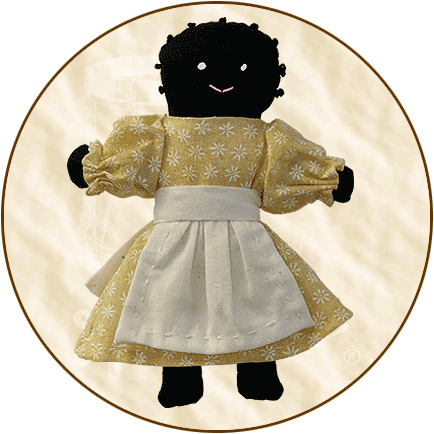.
Continued from product description on
Historical Doll Kits' Page Four...
Historical
Background: Dolls have been created for children in nearly
every culture. Handmade cloth rag dolls would have been popular
in the early American colonies since porcelain dolls from Europe
were very costly.
Slave children in the southern plantations were not allowed
to play with white dolls so their mothers or other relatives
made black dolls from scraps of cloth available to them, more
than likely from worn-out clothing. Surviving black rag dolls
have been found in "Underground Railroad" hideouts
where black slaves hid on their escape routes to the north for
freedom. A child would not have been able to carry much and,
in a hurry, could have dropped or misplaced a doll in the dark.
Since there is not much history written on handmade black
cloth dolls, much information is relied on from oral history
that has been passed down or from the actual dolls that were
found. After the Civil War, black women had few opportunities
available to them, except dressmaking, so some of them became
very skilled seamstresses. They would use the leftover scraps
from the beautiful clothes they made for their customers to make
elaborately dressed dolls.
Beginning in 1893, the E.I. Horseman Company manufactured
a black Babyland Rag Doll named "Dinah." This doll
was featured on a U.S. 32-cent stamp in 1997. A "Black Mammy"
cloth doll was produced around 1900 by the Babyland Rag Company,
which also made black dolls with lithographed faces. Patterns
for black dolls were produced during the first half of the 1900s.
Some of these vintage patterns are still available.
After the Civil Rights movement, black dolls became less popular,
but there is a resurgence in their interest today. Most of these
dolls are the cherished possessions of individuals, and some
are even featured in museums. Many of these dolls have become
collectibles and are considered to be valuable folk art.
Our Little Black Folk Doll Kit includes black cotton fabric;
muslin for the apron; calico for the dress; three colors of embroidery
floss; a needle to sew the doll, clothes, face and hair; stuffing;
pattern; instructions; and history.













